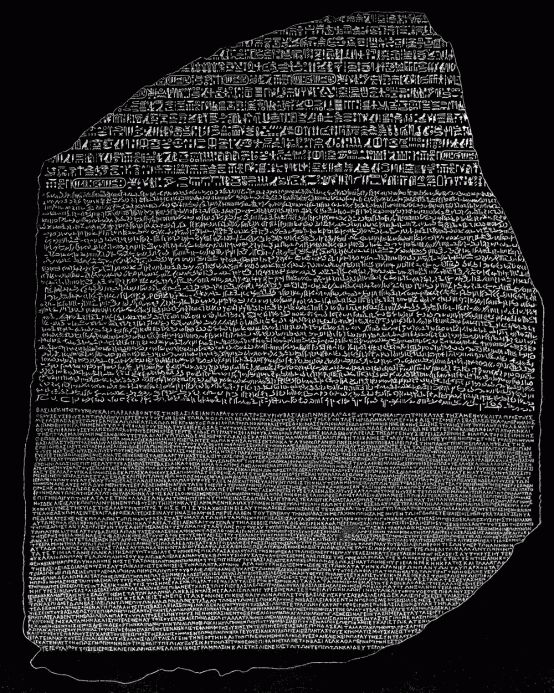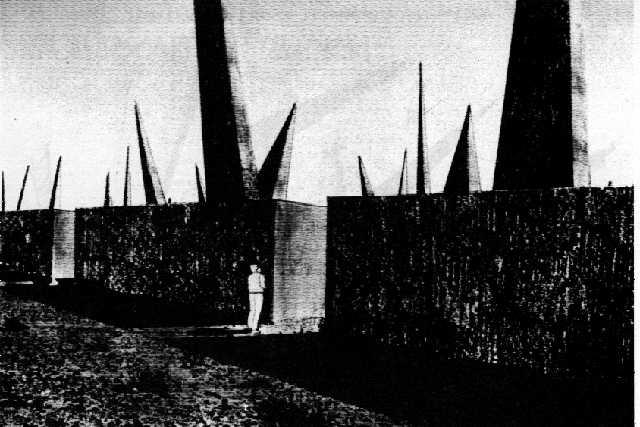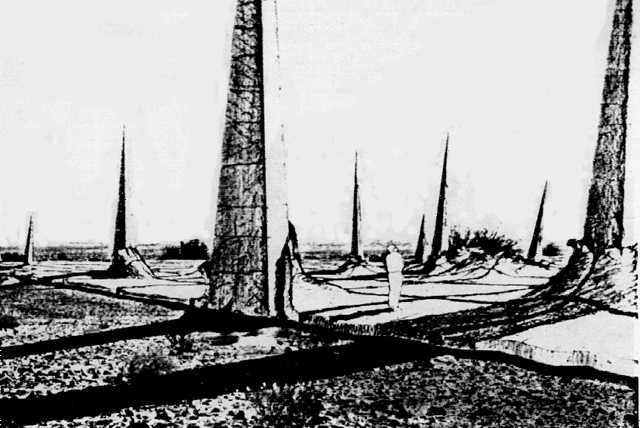How We Talk with Future Humans
14th of November, 2024

In Aneyoshi, Japan, along a road that follows an unsteady and rebellious ocean, stands an unremarkable stone, mossy and covered with mould. On it barely visible carvings can be noticed, faded by the entropy of time. Making just enough of an effort to decipher the faded message, one can read.
"Do not build any homes below this point. High dwellings are the peace and harmony of our descendants. Remember the calamity (catastrophy) of the great water"
In 2011, a catastrophic tsunami hit the beaches of the coastal villages. The residents who obeyed the message and lived in houses built above the marking line, all survived, with the water stopping only a couple hundred feet bellow the stone line. A mother with her 4 children, who decided to take a road going just bellow the stone line, were tragically washed away by the torrential waves.After the invention of the nuclear bomb, its' use in civilian purposes started growing year by year in developed countries - from US to the Soviet Union, France, Germany, Japan, and to the rest of the world. But as time went on, a small issue started growing and constantly pulling the legs of all parties involved, each time pulling harder and harder.
Generally, nuclear energy is a considerably clean and a little-waste method of energy production. Most of the waste generated (around 90%) is classified as low-level waste (LLW), consisting of ditched tools and work clothing. 3% of the waste is classified as high-level waste - mostly remnants of the nuclear reaction. Although 96% of it can be recycled, the rest will remain. And this small percent of a small percent will accumulate year to year. Today, we stand at 400.000 tonnes.
Radiation is one of the scariest deadly forces humanity has encountered. It doesn't kill you instantly, or do any superficial damage. An eye's blink of a sufficient radiation exposure could be enough to determine your fate - slow and painful death over the course of a few weeks. The radiation targets not you, but your DNA - destroying it and leaving your cells without an ability to reproduce. An although you may still walk and talk for a time, you're nothing but a talking corpse - slowly succumbing to nausea, skin destruction, agonising torturous pain.

Radioactive Magnetised Anode
In 1945, during the work on the Manhattan project, a single screwdriver slip and a few seconds of radiation exposure were enough to seal the fate of Dr. Louis Slotin. In the moments after the accident, Slotin stood quietly for a few moments, then remarked - "Well... that does it."
Getting rid of radioactive waste is not as easy as it sounds. If we dump it in the ocean, the contaminated water will hurt the marine organisms and spread through ocean currents. If we attempt to fly it to space, a single error could turn a spaceship into an intercontinental doomsday nuclear explosive. A safer way to get rid of the radioactive waste is burying it in repositories, and never taking them out, for at least 100.000 years. The oldest of all human creations haven't lasted a tenth of that amount.Who's to say that like the carvings on the Japanese stones, the memories of what those repositories are, and the instructions that we shouldn't open them, will not fade? They almost surely will. The only way to warn them is through messaging - and so we write messages to the future.
The governments of multiple nuclear countries, including the US and Finland, have commissioned special researches to come up with a reliable way to communicate this message to future human civilisation. In the US, the Sandia Report came up with the following message:
> This place is a message... and part of a system of messages... pay attention to it!
>
> Sending this message was important to us. We considered ourselves to be a powerful culture.
>
> This place is not a place of honour... no highly esteemed deed is commemorated here... nothing valued is here.
>
> What is here was dangerous and repulsive to us. This message is a warning about danger.
>
> The danger is in a particular location... it increases towards a centre... the centre of danger is here... of a particular size and shape, and below us.
>
> The danger is still present, in your time, as it was in ours.
>
> The danger is to the body, and it can kill.
>
> The form of the danger is an emanation of energy.
>
> The danger is unleashed only if you substantially disturb this place physically. This place is best shunned and left uninhabited.
The text was further translated into the world's most popular languages, and placed on the site. There is however one flaw within this line of reasoning. It is almost certain that all of the modern languages will disappear in the timespan of radioactive decay. Half to 90 percent of the world's languages are predicted to disappear in just the next century, many with little or no significant documentation - and that's not taking into consideration the languages that will evolve. The english of this text will be almost surely unintelligible in 4000 years. Though it is still unclear how our internet and globalisation age will influence the rate of change of languages. In the natural evolution, the naive assumption that humans will dramatically change is false and is based on a fundamental misunderstanding of how evolution works. Could here be something similar? After all, the global communication, the "mummification" of the written language all hint to this. Accents disappear. The corpora of human text grows from year to year. The spelling is unlikely to change - sunken cost fallacy comes handy when you have thousands of years of written data. At the other hand, the rapid development of jargon and language exchange also changes languages - and we can observe it ourselves, today. I can reach no conclusion, as I am no linguistic expert. I would love if someone would send his ideas on this topic to me, and would love a conversation about this.
That being said,
Almost 100 years ago, the mystery of the ancient Egyptian language was solved with the help of the miraculous discovery of the Rosetta stone. This little piece of text, containing a snippet of the same text in ancient Greek and Egyptian, broke the dam of the egyptological knowledge - and the water flushed the entire area completely. The text itself was hardly meant to be lasting, or important. In actuality, it deals with a fairy banal piece of bureaucracy - a copy of a decree passed in 196 BCE by a council of Egyptian priests celebrating the anniversary of the coronation of Ptolemy V as king of Egypt. The recovered text can be read here
Mimicking it, the Rosetta Project from the United States aims to render a contemporary version of the historic stone. Besides the online and physical, nano-etched archive, it also didn't forget its' roots. It will create the Rosetta Disk - a disk etched with 13,000 microscopic pages of text. One of the more interesting things it translated into a multitude of languages is the Swadesh List - the linguistic cultural anthropological universal. The list contains 100 terms - concepts understood by all humans, and possibly non-human intelligence. The list begins with I, you, we, this, that, who? what? not! all. many, one, two. big. woman. man. And it ends with black, night, hot, cold, full, new, good, round, dry, and lastly - name.

The Rosetta Stone
And so to avoid linguistic hurdles, scientists resolve to semiotics - symbols and culture universals. This approach comes with its' own challenges. Skull and bones - a symbol universally considered a marking of danger and death in our culture, may completely lose its' meaning in the coming decades. One can draw a comic detailing a human getting in contact with the disposed material and slowly falling ill. Read it left to right instead of right to left and you see a sick man miraculously getting healthy after obtaining a splendid material, buried right here, underground. It's stupid enough to laugh off, but realistic enough to still worry about.
A possible solution could be the use of hostile architecture. Some of the proposed solutions are landscapes of thorns, fields of spikes, an enormous black hole of basalt, and a network of slabs and blocks forming streets which would invoke the feeling of ominous and lead nowhere - dyed black, and turning an entire area unsuitable for farming or other use. We rely on the assumption that a future civilisation would surely be smarter than us, and understand the meaning of the repository. But at the same time, we are talking about a time scale constituting half of the current existence of Homo Sapiens itself. A nuclear repository could be interpreted as a religious temple, a treasure dungeon, or otherwise a place worth digging and investigating to better understand ourselves, much like the Egyptian Pyramids - inadvertently reaching the effect opposite the one intended. In Norway, a stone slab was placed on the ground and marked with runes - "Do NOT under any circumstances move this Slab". Archeologists disregarded the message and moved the slab, revealing nothing beneath it. A repeat of this scenario in 100.000 years could prove more tragic. The Pyramids, covered with curses and structures warding off intruders, could also hardly prevent archeologists from scavenging them. And even if future humans understand the danger, it could, in desperate times, not be enough to ward them off from the riches, which could become catastrophically rare in case humanity's future turns bleak, namely uranium and copper.


The stone streets
There have been more outlandish ideas aimed at keeping our future descendants aware of the danger. The Roman empire went through a cycle of rise, prosperity, decay, and death. Similar fate awaits the modern western civilisation - no country on today's world map will be there in ten thousand years. One day, there will be no France, no Russia, no China, and no Argentina. The Catholic Church outlived Rome. It's oral and religious traditions still flourish to this day. Similarly, a more outlandish idea has been the creation of what can dramatically be called "an atomic priesthood", which will retain the information about those sites in oral traditions, "ceremonies" and "rituals". Another idea proposed the breeding of special radioactive cats, which will glow when passing by a radiation dump, although I cannot comprehend how this is supposed to let future humans be aware of the danger.
How will they understand us? How will they know our language, our symbols, our struggles? How do we make sure that future humans can understand our age?
One of the more interesting projects in this regard is the Memory of Mankind project, consisting of several billion information points for our future selves. Information is printed on ceramic tablets and stored in a salt mine in Australia. An instruction for a somewhat religious rite is attached to this token: the owners are supposed to gather every 50 years to commemorate and decide whether humanity still knows the content of MOM and if extensions are needed. If the knowledge about it is lost, its' recovery instructions and location indicators are written in a complex mathematical way - in order to ensure, that a future potentially degraded human civilisation will not prematurely gain access to the information and damage it. You, yourself, can become part and contribute your own information to one of those tablets. The text you are reading now will be added to the Library as well, for the future historians to read and marvel at.
The Finish team behind Onkala, the biggest repository of nuclear waste in Europe, after long years of planning and discussions, decided to not mark the burial ground by anything. They made a gamble - a gamble, that the humans in the future will be smarter and more technologically advanced than us, and will be in a sufficient economic condition to not resort to disturbing the location. And if some catastrophic force wipes off civilisation, there should be nothing forcing them to dig into a tundra. The least we can do, is hope. I hope so too.
▬▬▬▬▬▬▬▬▬▬▬▬▬▬▬▬▬▬▬▬▬▬▬▬▬▬▬▬▬▬▬▬▬▬▬▬▬▬▬▬▬▬▬▬▬▬
In Georgia, humans less optimistic of future technical progress erected guide stones for our future descendants, supposed to last for thousands of years and to be the testament to the highest technological point of human history. On them instructions were inscribed on rebuilding a civilisation, better than ours.

The Georgia Guidestones.
Maintain humanity under 500,000,000 in perpetual balance with nature.
>
Guide reproduction wisely – improving fitness and diversity.
>
Unite humanity with a living new language.
>
Rule passion – faith – tradition – and all things with tempered reason.
>
Protect people and nations with fair laws and just courts.
>
Let all nations rule internally resolving external disputes in a world court.
>
Avoid petty laws and useless officials.
>
Balance personal rights with social duties.
>
Prize truth – beauty – love – seeking harmony with the infinite.
>
Be not a cancer on the Earth – Leave room for nature
>
Leave room for nature.
In 2022, a Christian fundamentalist activist bombed the granite statues into oblivion. They will not be read again.